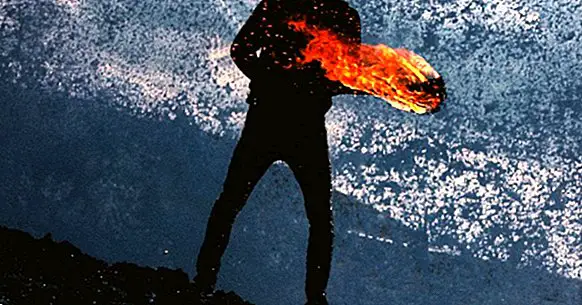Arsonfobia (fear of fire): causes, symptoms and treatment
Throughout the history of mankind, fire has played a role both as an ally and as an enemy of man. Thanks to him, a great number of advances and inventions have been possible that have meant an improvement in the development of humanity.
However, we can not ignore the danger of this. Since badly controlled, it can become deadly, hence the fear it arouses among people. However, when this fear becomes excessive, we may find ourselves facing a case of arsonphobia .
Related article: "The 15 purest phobias that exist"
What is arsonophobia?
Within the long list of existing specific phobias, arsonphobia is that anxiety disorder in which the person experiences a pathological fear of fire or fires . This phobia can also be known under the name of pyrophobia.
As with the rest of specific anxiety disorders, when people with arsonophobia face or think they must face the feared stimulus, a series of reactions, both physical and psychological, typical of very high stress and anxiety states begin.
It is understandable that a person may experience a certain degree of fear in the presence of fire and even more in the face of a fire, this is considered a normal and adaptive fear, which appears as a survival response. But nevertheless, If this response is generalized to any situation and is disproportionate it can be considered as a specific phobia, specifically arsonphobia .
How to differentiate it from a normative fear?
There are a series of specific characteristics that allow us to establish a difference between a habitual reaction or response to a danger and a phobia or pathological fear. For this, we must take into account what consequences or direct effects this fear has on the day to day of the person.
Therefore, in cases in which the person suffers arsonphobia, it will experience strong reactions of anxiety before the appearance of the phobic or aversive stimulus; in this case the fire. In addition, it is very possible that this fear causes interference at the time of carrying out a normal life, so it is always advisable to consult with a professional psychologist.
Finally, it is necessary to take into account a series of requirements and qualities of fear disorders, which serve to define the phobia and enable its diagnosis. These qualities are the following.
1. It results in a disproportionate fear
One of the features that differentiates a natural fear from a disproportionate fear is that in arsonphobia the sensation of fear experienced is completely disproportionate in comparison with the real threat posed by the phobic stimulus.
In this case, the person may react in an exaggerated manner to the perception of a burning match or even before a kitchen stove on.
2. It is irrational
Subjects with arsonphobia they are absolutely unable to find a reasonable and justified explanation for their reactions of fear . To the point that, in many cases, the person is perfectly aware that the stimulus is not dangerous in itself but still is unable to prevent the appearance of the anxiety response to it.
3. It is uncontrollable
Finally, the third characteristic that defines a phobic fear is that this fear is absolutely uncontrollable for the person with arsonphobia. This means that the person can not avoid the occurrence of anxiety and fear reactions, nor can he control them while experiencing them.
symptom
Because arsonophobia is one more in the list of specific phobias, its symptomatology is very similar to that of other pathological fears of this type . The clinical picture is distinguished by being of an anxious nature and appears every time the person faces or thinks about situations related to fire or fires.
This clinical picture is classified into physical symptoms, cognitive symptoms and behavioral symptoms; which usually appear automatically and suddenly, and only disappear when the person has managed to escape or avoid the phobic stimulus.
1. Physical symptoms
The first symptoms that the patient with arsonphobia is aware of are the physical symptoms. The appearance of the phobic stimulus, the fire, causes an overactivity of the nervous system of the person which triggers all kinds of changes and transformations in it.
Between the symptoms that may appear throughout a phobic episode we find :
- Increase in heart rate
- Increase in the respiratory rate
- Feeling short of breath or shortness of breath
- Increase in muscle tension
- Headache
- Gastrointestinal problems such as stomach pain or diarrhea
- Increased sweating
- Vertigo and feeling dizzy
- Nausea and / or vomiting
2. Cognitive symptoms
Another group of symptoms that appear in arsonphobia are cognitive symptoms. These consist of a series of beliefs and speculations, which can become obsessive , in relation to the fear of fire and fires.
These distorted thoughts and ideas favor the advance and development of the phobia and are distinguished because the person possesses a series of illogical and irrational beliefs about the danger of fire. In addition, these symptoms are often accompanied by mental images of a catastrophic nature about this element.
3. Behavioral symptoms
As in the rest of specific anxiety disorders, arsonphobia is also accompanied by behavioral symptoms. These symptoms manifest themselves through avoidance behaviors and escape behaviors .
The avoidance behaviors refer to all those behaviors or acts that the person carries out to avoid encountering the phobic stimulus and thus avoid the experimentation of negative sensations. An example may be the refusal to cook with fire or to use any gas appliance that could cause a fire.
On the other hand, escape behaviors are manifested when the subject has not been able to avoid in confrontation with the phobic stimulus, so he will carry out any behavior that is necessary to escape from the situation in which he is and generates high levels of anxiety.
Causes
Although it is sometimes difficult to determine the specific origin of a phobia, since even the patient is not able to associate it with any traumatic event, There are a number of factors that can promote or enhance the emergence and development of this pathological fear .
The existence of a genetic predisposition to the effects of anxiety and stress, coupled with the experience or experimentation of a highly traumatic situation or with a high emotional load in which the fire appeared in any way, can trigger, most likely , the appearance of arsonphobia.
In any case, the impact that vicarious or imitative learning can have at the moment of acquiring a phobia is being studied.
Treatment
Although it is not known exactly the incidence that this phobia has the population, it is estimated that this appears more frequently in those whose jobs involve contact with fire to a greater or lesser extent, such as firemen or forest agents .
Both in these cases and in that of any other person suffering from this disorder, there are some interventions and psychological treatments that can achieve the reduction of symptoms and, even, that the person replenishes and overcomes his phobic fear.
The psychological treatment is based on three different principles or actions . The first is to carry out a cognitive restructuring that promotes the modification of the distorted thoughts that the person has with respect to fire.
In addition, live exposure techniques or systematic desensitization will be carried out, through which the patient is exposed, gradually to the stimulus or phobic situation. This can be done live, in controlled environments and contexts, or through the imagination.
Finally, these techniques are accompanied by a training in relaxation skills, which can reduce levels of excitation of the nervous system and help the person to face their fears in the best way possible.



















